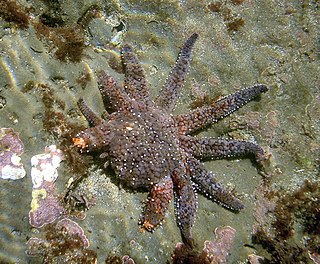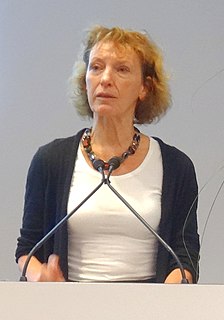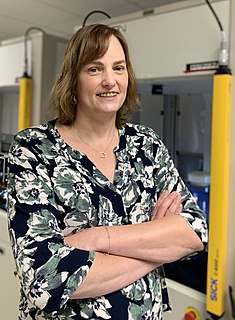Related Research Articles

The zebrafish is a freshwater fish belonging to the minnow family (Cyprinidae) of the order Cypriniformes. Native to South Asia, it is a popular aquarium fish, frequently sold under the trade name zebra danio. It is also found in private ponds.
Developmental biology is the study of the process by which animals and plants grow and develop. Developmental biology also encompasses the biology of regeneration, asexual reproduction, metamorphosis, and the growth and differentiation of stem cells in the adult organism.
Zoology is the branch of biology that studies the animal kingdom, including the structure, embryology, evolution, classification, habits, and distribution of all animals, both living and extinct, and how they interact with their ecosystems. The term is derived from Ancient Greek ζῷον, zōion ('animal'), and λόγος, logos.

Bonnie Lynn Bassler is an American molecular biologist; the Squibb Professor in Molecular Biology and chair of the Department of Molecular Biology at Princeton University; and a Howard Hughes Medical Institute Investigator. She has researched cell-to-cell chemical communication in bacteria and discovered key insights into the mechanism by which bacteria communicate, known as quorum sensing. She has contributed to the idea that disruption of chemical signaling can be used as an antimicrobial therapy.

A planarian is one of many flatworms of the traditional class Turbellaria. It usually describes free-living flatworms of the order Tricladida (triclads), although this common name is also used for a wide number of free-living platyhelminthes. Planaria are common to many parts of the world, living in both saltwater and freshwater ponds and rivers. Some species are terrestrial and are found under logs, in or on the soil, and on plants in humid areas.

In biology, regeneration is the process of renewal, restoration, and tissue growth that makes genomes, cells, organisms, and ecosystems resilient to natural fluctuations or events that cause disturbance or damage. Every species is capable of regeneration, from bacteria to humans. Regeneration can either be complete where the new tissue is the same as the lost tissue, or incomplete where after the necrotic tissue comes fibrosis.

Dame Anne Laura Dorinthea McLaren, was a British scientist who was a leading figure in developmental biology. Her work helped lead to human in vitro fertilisation (IVF), and she received many honours for her contributions to science, including election as fellow of the Royal Society.

The Annual Review of Genetics is an annual peer-reviewed scientific review journal published by Annual Reviews. It was established in 1967 and covers all topics related to the genetics of viruses, bacteria, fungi, plants, and animals, including humans. The current editor is Tatjana Piotrowski. As of 2021, Journal Citation Reports gives the journal a 2020 impact factor of 16.830, ranking it fourth out of 175 journals in the category "Genetics & Heredity".
Hearing Health Foundation (HHF) is a 501(c)(3) nonprofit organization whose mission is to prevent and cure hearing loss and tinnitus through groundbreaking research, and promote hearing health. In 2011, the Deafness Research Foundation changed its name to Hearing Health Foundation.

Maria Leptin is a German developmental biologist and immunologist, and the current President of the European Research Council. She was the Director of the European Molecular Biology Organization from 2010 to 2021.
Epimorphosis is defined as the regeneration of a specific part of an organism in a way that involves extensive cell proliferation of somatic stem cells, dedifferentiation, and reformation, as well as blastema formation. Epimorphosis can be considered a simple model for development, though it only occurs in tissues surrounding the site of injury rather than occurring system-wide. Epimorphosis restores the anatomy of the organism and the original polarity that existed before the destruction of the tissue and/or a structure of the organism. Epimorphosis regeneration can be observed in both vertebrates and invertebrates such as the common examples: salamanders, annelidas, and planarians.

Alejandro Sánchez Alvarado is a molecular biologist, an investigator of the Howard Hughes Medical Institute, and Executive Director and Chief Scientific Officer of the Stowers Institute for Medical Research. The Sánchez Alvarado Laboratory focuses on understanding the regenerative capabilities of the planarian flatworm Schmidtea mediterranea. In 2015, Sánchez Alvarado was elected a fellow of the American Academy of Arts and Sciences, and to the National Academy of Sciences in 2018 for his distinguished and continuing achievements in original scientific research.

Professor Melissa Little is an Australian scientist and academic, currently Theme Director of Cell Biology, heading up the Kidney Regeneration laboratory at the Murdoch Children's Research Institute. She is also a Professor in the Faculty of Medicine, Dentistry and Health Sciences, University of Melbourne, and Program Leader of Stem Cells Australia. In January 2022, she became CEO of the Novo Nordisk Foundation Center for Stem Cell Medicine reNEW, an international stem cell research center based at University of Copenhagen, and a collaboration between the University of Copenhagen, Denmark, Murdoch Children’s Research Institute, Australia, and Leiden University Medical Center, The Netherlands.

Kenneth D. Poss is an American biologist and currently James B. Duke Professor of Cell Biology and director of the Regeneration Next Initiative at the Duke University School of Medicine.

Robyn Leigh Tanguay is an American researcher, academic and educator. She is a Distinguished Professor in the Department of Environmental and Molecular Toxicology at Oregon State University. She is the director of Superfund Research Program, the director of Pacific Northwest Center for Translational Environmental Health Research and the director of Sinnhuber Aquatic Research Laboratory at OSU.
Billie J. Swalla is a professor of biology at the University of Washington. She was the first female director of Friday Harbor Laboratories, where she served from 2012–2019. Her lab investigates the evolution of chordates by comparative genetic and phylogenetic analysis of animal taxa.

Neoblasts (ˈniːəʊˌblæst) are non-differentiated cells found in flatworms called planarians. Neoblasts make up about 30 percent of all cells in planaria. Neoblasts give planarians an extraordinary ability to regenerate lost body parts. A planarian split lengthwise or crosswise will regenerate into two separate individuals.

Andrew 'Andy' Charles Oates is an Australian and British developmental biologist and embryologist specialized in biological pattern formation. He is professor at EPFL and head of the Segmentation Timing and Dynamics Laboratory at EPFL's School of Life Sciences. Since 2021, he has been dean of EPFL's School of Life Sciences.
Julia Anne Horsfield is a New Zealand biochemist and developmental geneticist. She is professor of pathology at the University of Otago and director of Genetics Otago and the Otago Zebrafish Facility.
Elizabeth Patton, Ph.D FRSE is professor of chemical genetics and group leader of Medical Research Council Institute for Genetics and Molecular Medicine (IGMM) Human Genetics Unit in Edinburgh, Personal Chair of Melanoma Genetics and Drug Discovery for a disease which kills 20,000 Europeans a year, and accounts for 80% of all skin cancer deaths. Her research into the genetic models and drug interactions testing, sharing international findings, is mainly using zebrafish in conjunction with the Edinburgh Cancer Research Centre. She holds a number of academic leadership roles in UK, Europe and international scientific bodies.
References
- 1 2 3 Anderson Orr, Anissa (2017). "A DISCUSSION WITH TATJANA PIOTROWSKI, PHD". Stowers Institute for Medical Research. Retrieved 9 February 2021.
- ↑ "STOWERS INSTITUTE RECRUITS TOP SCIENTISTS IN DEVELOPMENTAL AND REGENERATIVE BIOLOGY". 20 June 2011. Retrieved 9 February 2021.
- 1 2 "Investigator Tatjana Piotrowski appointed to prestigious editorial role". Stowers Institute for Medical Research. February 8, 2022. Retrieved 9 February 2022.
- ↑ "TATJANA PIOTROWSKI, PH.D." Hearing Health Foundation. Retrieved 9 February 2021.
- ↑ "Annual Review of Genetics, Current Editorial Committee". Annual Reviews. Retrieved 9 February 2021.
- ↑ "A DISCUSSION WITH ALEJANDRO SÁNCHEZ ALVARADO". Stowers Institute for Medical Research. 2019. Retrieved 9 February 2021.